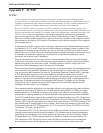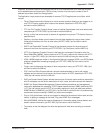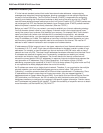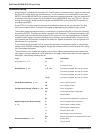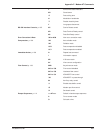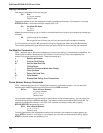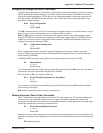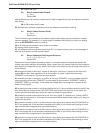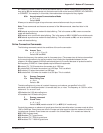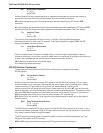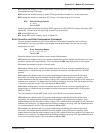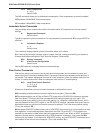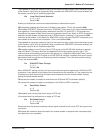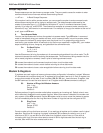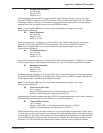
RASFinder RF300E/RF310E User Guide
RF300E/RF310E
170
E1 enables the echo.
Qn Result Codes Enable/Disable
n = 0 or 1
Default: Q0
Use the Q command to enable or disable result codes for applications such as computer-controlled
auto dialing.
Q0 (or Q) enables result codes.
Q1 disables result codes for applications such as computer-controlled auto-dialing.
Vn Result Codes (Verbose/Terse)
n = 0 or 1
Default: V1
The V command controls whether the modem’s result codes display as text (verbose) or numeric
(terse) messages. For example, if no carrier signal is detected after dialing, the result can display
either as NO CARRIER or as the number 3.
V0 (or V) displays the modem’s result codes as a number.
V1 displays result codes as text.
V2, an additional command given anytime after ATV1 is entered, displays the connect message of
both the local modem and the remote modem.
Xn Result Codes and Call Progress Selection
n = 0, 1, 2, 3, 4, 5, 6, or 7
Default: X4
Selects which result codes the modem provides in command mode and determines whether the
modem uses smart dialing or blind dialing. When it smart dials, the modem listens for dial tones and
busy signals and responds to them. When it blind dials, the modem ignores the signals and relies on
timing instead.
X0 causes the modem to blind dial. Instead of looking for a dial tone, it pauses for the time set in
register S6 and then dials regardless. Once a connection is made, it sends the basic code
CONNECT to the terminal. It ignores any busy signals.
X1 causes the modem to blind dial. In addition to the basic CONNECT code, it provides extended
codes consisting of the word CONNECT and the speed of the connection (CONNECT 14400 or
CONNECT 28800, for example). In this mode, the modem does not recognize or respond to dial
tones or busy signals.
X2 causes the modem to wait for a dial tone before dialing. If it does not detect a dial tone within the
time set by S6, the modem sends a NO DIALTONE result code to the terminal. In this mode, the
modem provides extended result codes but does not respond to busy signals.
X3 causes the modem to blind dial and to look for a busy signal. If it detects one, it sends a BUSY
result code to the terminal. In this mode, the modem provides extended result codes, but it does not
respond to dial tones.
X4 causes the modem to look for a dial tone and a busy signal and respond with NO DIALTONE or
BUSY, as appropriate. It also provides extended result codes. It is the most useful setting for most
data communication programs and is the default setting.
X5 causes the modem to look for a dial tone and a busy signal and respond with NO DIALTONE or
BUSY, as appropriate. It also provides extended result codes. It is the most useful setting for most
data communication programs and is the default setting.
X6 causes the modem to look for a dial tone and a busy signal and respond with NO DIALTONE or
BUSY, as appropriate. It also provides extended result codes. It is the most useful setting for most
data communication programs and is the default setting.



